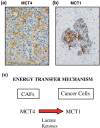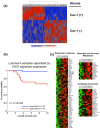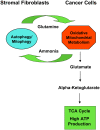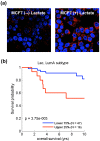Understanding the Warburg effect and the prognostic value of stromal caveolin-1 as a marker of a lethal tumor microenvironment
- PMID: 21867571
- PMCID: PMC3236330
- DOI: 10.1186/bcr2892
Understanding the Warburg effect and the prognostic value of stromal caveolin-1 as a marker of a lethal tumor microenvironment
Abstract
Cancer cells show a broad spectrum of bioenergetic states, with some cells using aerobic glycolysis while others rely on oxidative phosphorylation as their main source of energy. In addition, there is mounting evidence that metabolic coupling occurs in aggressive tumors, between epithelial cancer cells and the stromal compartment, and between well-oxygenated and hypoxic compartments. We recently showed that oxidative stress in the tumor stroma, due to aerobic glycolysis and mitochondrial dysfunction, is important for cancer cell mutagenesis and tumor progression. More specifically , increased autophagy/mitophagy in the tumor stroma drives a form of parasitic epithelial-stromal metabolic coupling. These findings explain why it is effective to treat tumors with either inducers or inhibitors of autophagy, as both would disrupt this energetic coupling. We also discuss evidence that glutamine addiction in cancer cells produces ammonia via oxidative mitochondrial metabolism. Ammonia production in cancer cells, in turn, could then help maintain autophagy in the tumor stromal compartment. In this vicious cycle, the initial glutamine provided to cancer cells would be produced by autophagy in the tumor stroma. Thus, we believe that parasitic epithelial-stromal metabolic coupling has important implications for cancer diagnosis and therapy, for example, in designing novel metabolic imaging techniques and establishing new targeted therapies. In direct support of this notion, we identified a loss of stromal caveolin-1 as a marker of oxidative stress, hypoxia, and autophagy in the tumor microenvironment, explaining its powerful predictive value. Loss of stromal caveolin-1 in breast cancers is associated with early tumor recurrence, metastasis, and drug resistance, leading to poor clinical outcome.
Figures






Similar articles
-
Tumor microenvironment and metabolic synergy in breast cancers: critical importance of mitochondrial fuels and function.Semin Oncol. 2014 Apr;41(2):195-216. doi: 10.1053/j.seminoncol.2014.03.002. Epub 2014 Mar 5. Semin Oncol. 2014. PMID: 24787293 Review.
-
Stromal-epithelial metabolic coupling in cancer: integrating autophagy and metabolism in the tumor microenvironment.Int J Biochem Cell Biol. 2011 Jul;43(7):1045-51. doi: 10.1016/j.biocel.2011.01.023. Epub 2011 Feb 15. Int J Biochem Cell Biol. 2011. PMID: 21300172 Free PMC article. Review.
-
Using the "reverse Warburg effect" to identify high-risk breast cancer patients: stromal MCT4 predicts poor clinical outcome in triple-negative breast cancers.Cell Cycle. 2012 Mar 15;11(6):1108-17. doi: 10.4161/cc.11.6.19530. Epub 2012 Mar 15. Cell Cycle. 2012. PMID: 22313602 Free PMC article.
-
Autophagy in cancer associated fibroblasts promotes tumor cell survival: Role of hypoxia, HIF1 induction and NFκB activation in the tumor stromal microenvironment.Cell Cycle. 2010 Sep 1;9(17):3515-33. doi: 10.4161/cc.9.17.12928. Epub 2010 Sep 9. Cell Cycle. 2010. PMID: 20855962 Free PMC article.
-
Glutamine fuels a vicious cycle of autophagy in the tumor stroma and oxidative mitochondrial metabolism in epithelial cancer cells: implications for preventing chemotherapy resistance.Cancer Biol Ther. 2011 Dec 15;12(12):1085-97. doi: 10.4161/cbt.12.12.18671. Epub 2011 Dec 15. Cancer Biol Ther. 2011. PMID: 22236876 Free PMC article.
Cited by
-
Mitophagy: insights into its signaling molecules, biological functions, and therapeutic potential in breast cancer.Cell Death Discov. 2024 Oct 29;10(1):457. doi: 10.1038/s41420-024-02226-6. Cell Death Discov. 2024. PMID: 39472438 Free PMC article. Review.
-
Oncogenes induce the cancer-associated fibroblast phenotype: metabolic symbiosis and "fibroblast addiction" are new therapeutic targets for drug discovery.Cell Cycle. 2013 Sep 1;12(17):2723-32. doi: 10.4161/cc.25695. Epub 2013 Jul 30. Cell Cycle. 2013. PMID: 23860382 Free PMC article. Review.
-
Six stroma-based RNA markers diagnostic for prostate cancer in European-Americans validated at the RNA and protein levels in patients in China.Oncotarget. 2015 Jun 30;6(18):16757-65. doi: 10.18632/oncotarget.4430. Oncotarget. 2015. PMID: 26158290 Free PMC article.
-
Metabolic remodeling in human colorectal cancer and surrounding tissues: alterations in regulation of mitochondrial respiration and metabolic fluxes.Biochem Biophys Rep. 2015 Aug 29;4:111-125. doi: 10.1016/j.bbrep.2015.08.020. eCollection 2015 Dec. Biochem Biophys Rep. 2015. PMID: 29124194 Free PMC article.
-
The Warburg effect: 80 years on.Biochem Soc Trans. 2016 Oct 15;44(5):1499-1505. doi: 10.1042/BST20160094. Biochem Soc Trans. 2016. PMID: 27911732 Free PMC article. Review.
References
Publication types
MeSH terms
Substances
Grants and funding
LinkOut - more resources
Full Text Sources
Other Literature Sources
Medical

